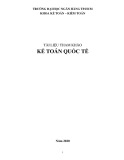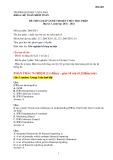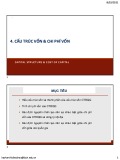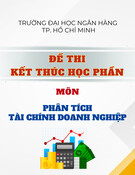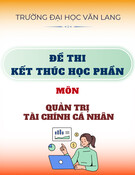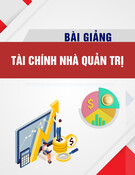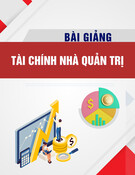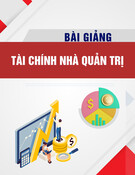
SITPRO
International Trade Guides
Methods of
Payment in
International
Trade
Financial

Methods of Payment in International Trade
This guide explains the different methods of getting paid and the different levels of risks involved.
You should note that none of the methods outlined below will completely eliminate the payment
risks associated with international trade, so you should consider your preferred payment option
with care and hedge the risks along with appropriate credit insurance and credit checks on your
customers.
You should read it if you trade internationally and want to know what your options are in making
and receiving international payments. You may wish to pass on the information in this Briefing to
your colleagues in the Sales & Marketing team and your Finance Director so that they are aware
of these issues.
Introduction
Getting paid for providing goods or services is critical for any business. However, getting paid for
an international transaction (also commonly known as "export receivables") can be a very
different experience from securing payment on business with other UK entities, due to the
number of extra factors that can influence the process.
The main factor in considering how an exporter expects to be paid for a transaction is the
potential risk that they and their customer are willing to face between them - don't forget, there
are always two sides to any situation. There are different types of risk that you will face as an
exporter, this briefing will consider the payment risk.
Payment Risk Ladder
It is often a good idea, during, or even before contract negotiations, to consider where, on the
diagram below, you and your customer will be comfortable in placing yourselves.
2SITPRO Financial Guide: Methods of Payment in International Trade
Exporter
Least Secure
Most Secure
Importer
Most Secure
Least Secure
Open Account
Bills for Collection
Letters of Credit
Advance Payments

Open Account
This is the least secure method of trading for the exporter, but the most attractive to buyers.
Goods are shipped and documents are remitted directly to the buyer, with a request for payment
at the appropriate time (immediately, or at an agreed future date). An exporter has little or no
control over the process, except for imposing future trading terms and conditions on the buyer.
Clearly, this payment method is the most advantageous for the buyer, in cash flow and cost
terms. As a consequence, Open Account trading should only be considered when an exporter is
sufficiently confident that payment will be received.
In certain markets, such as Europe, buyers will expect Open Account terms. The financial risk
can often be mitigated by obtaining a credit insurance policy to cover the potential insolvency of
a customer, that provides reimbursement up to an agreed financial limit. A number of commercial
insurers specialise in this market - contact your insurance representative for details.
Advance Payment
The most secure method of trading for exporters and, consequently the least attractive for
buyers. Payment is expected by the exporter, in full, prior to goods being shipped.
As one might imagine, having covered the two extremes on the Payment Risk Ladder,
commercial decisions have to be made and this usually results in selecting one of the middle
rungs of the ladder. This is where banking products such as Bills for Collection and Letters of
Credit come in to play.
Bills for Collection
More secure for an exporter than Open Account trading, as the exporter's documentation is sent
from a UK bank to the buyer's bank. This invariably occurs after shipment and contains specific
instructions that must be obeyed. Should the buyer fail to comply, the exporter does, in certain
circumstances, retain title to the goods, which may be recoverable. The buyer's bank will act on
instructions provided by the exporter, via their own bank, and often provides a useful
communication route through which disputes are resolved.
The Bills for Collection process is governed by a set of rules, published by the International
Chamber of Commerce (ICC) called "Uniform Rules for Collections" document number 522
(URC522). Over 90% of the world's banks adhere to this document - pick up a copy from the
ICC (See contact details below) or your bank and familiarise yourself with the contents.
There are two types of Bill for Collection, which are usually determined by the payment terms
agreed within a commercial contract. Different benefits are afforded to exporters by each and
they are covered separately below.
SITPRO Financial Guide: Methods of Payment in International Trade

Documents against Payment (D/P)
Usually used where payment is expected from the buyer immediately, otherwise known as "at
sight". This process is often referred to as "Cash against Documents".
The buyer's bank is instructed to release the exporter's documents only when payment has been
made. Where goods have been shipped by sea freight, covered by a full set of Bills of Lading,
title is retained by the exporter until these documents are properly released to the buyer.
Unfortunately, for airfreight items, unless the goods are consigned to the buyer's bank no such
control is available under an Air Waybill or Air Consignment Note, as these documents are
merely "movement certificates" rather than "documents of title" (N.B. Under URC522, goods
should not be consigned to a bank without prior approval). Similarly there is no such control
available for road or rail transport.
Documents against Acceptance (D/A)
Used where a credit period (e.g. 30/60/90 days - 'sight of document' or from 'date of shipment')
has been agreed between the exporter and buyer. The buyer is able to collect the documents
against their undertaking to pay on an agreed date in the future, rather than immediate payment.
The exporter's documents are usually accompanied by a "Draft" or "Bill of Exchange" which
looks something like a cheque, but is payable by (drawn on) the buyer. When a buyer (drawee)
agrees to pay on a certain date, they sign (accept) the draft. It is against this acceptance that
documents are released to the buyer. Up until the point of acceptance, the exporter may retain
control of the goods, as in the D/P scenario above. However, after acceptance, the exporter is
financially exposed until the buyer actually initiates payment through their bank.
Bills for Collection are used in certain markets (particularly Asian) to fulfil Exchange Control
Regulations. They are a cost-effective method of evidencing a transaction for buyers, where
documents are handled (and reported) via the banking system.
Letters of Credit (L/Cs)
A Letter of Credit (also known as a Documentary Credit ) is a bank-to-bank commitment of
payment in favour of an exporter (the Beneficiary), guaranteeing that payment will be made
against certain documents that, on presentation, are found to be in compliance with terms set by
the buyer (the Applicant).
Like Bills for Collections, Letters of Credit are governed by a set of rules from the ICC. In this
case, the document is called; "Uniform Customs and Practice" and the latest version is document
number 600. In short, it is known as UCP600 and, again, over 90% of the world's banks adhere
to this document.
4
SITPRO Financial Guide: Methods of Payment in International Trade

Irrevocable: The terms and conditions within a L/C cannot be changed without the express
agreement of the Beneficiary. Under UCP600, revocable L/Cs are no longer acceptable under
any circumstances.
Unconfirmed: The payment commitment within the L/C is provided by the Applicant's issuing
bank.
Confirmed: If an exporter has any concerns about the circumstances which may prevent
payment being made from either the Issuing Bank or buyer's Country, the adding of
"Confirmation" moves the bank/country risk issues to the bank which adds its confirmation (the
confirming or advising bank) and notifies the DC to the exporter. The price of such a confirmation
will obviously depend upon the level of perceived risks to be covered. Banks can often provide
indicative pricing for confirmations prior to the arrival of the DC, so that costs can be estimated.
What does all this mean?
The exporter and buyer can agree detailed terms, as part of the commercial contract. This can
include exactly what documents need to be produced and precisely what detail such documents
should quote. Letters of Credit, as well as offering a bank's commitment to pay, also offer
benefits in terms of finance. Speak to your bank, or the Advising/Confirming Bank to see how
they can help. Additionally, commercial insurers now offer an insurance-backed product that
covers the same basic risks as confirmations. Please speak to your insurer for details.
Standby Letters of Credit (SBLCs) or Bank Guarantees
SBLCs are similar to Bank Guarantees, in that they sit behind a transaction and are only called
upon if the buyer fails to pay in the normal course of business (which is often Open Account).
They can be particularly useful to cover an underlying financial risk where multiple payments are
to be made, possibly as part of an agreed schedule. However, they do not offer the documentary
control of Letters of Credit to buyers and, as such they are an unconditional guarantee.
Other International Trade Risks
Customer Risks
Can they/will they pay? Exporters should find out everything they can about their buyers. Banks
can help by contacting the buyer's bank for a reference. Many commercial organisations can
provide credit information at relatively little cost. Does the exporter have any local contacts or
agents who might be prepared to undertake some research?
On the basis of this information, the exporter can start to think about his stance in terms of the
payment risk ladder.
5SITPRO Financial Guide: Methods of Payment in International Trade





